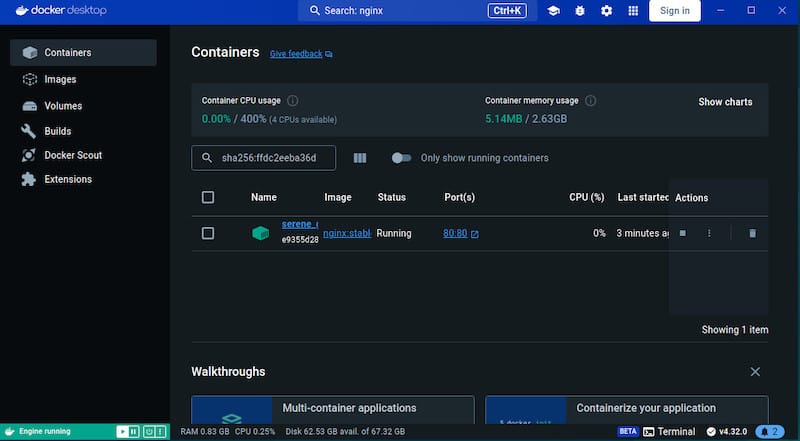How To Install Docker Desktop on Ubuntu 24.04 LTS

Docker has revolutionized the way developers build, ship, and run applications. By leveraging containerization, Docker allows for consistent environments across different stages of development and deployment. For users of Ubuntu 24.04 LTS, Docker Desktop provides a powerful GUI interface to manage containers seamlessly. This guide will walk you through the process of installing Docker Desktop on your Ubuntu system, ensuring that you are equipped with all the necessary tools to get started.
What is Docker?
Docker is an open-source platform designed to automate the deployment, scaling, and management of applications using container technology. Containers package an application and its dependencies into a single unit, ensuring that it runs consistently across various computing environments. Unlike traditional virtual machines, containers share the host system’s kernel, making them lightweight and efficient.
Docker Desktop enhances this experience by providing a user-friendly graphical interface that simplifies container management. With features like easy image management, integrated Kubernetes support, and a streamlined workflow for building applications, Docker Desktop is an essential tool for developers working in a modern software ecosystem.
Prerequisites for Installation
Before diving into the installation process, ensure that your system meets the following prerequisites:
- System Requirements:
- 64-bit CPU with virtualization support enabled in BIOS.
- A minimum of 4 GB RAM.
- KVM virtualization support (check with
egrep -c '(vmx|svm)' /proc/cpuinfocommand). - A desktop environment with system tray support (e.g., GNOME or KDE).
- Software Prerequisites:
- Ensure that your Ubuntu system is updated to the latest version.
- Install essential packages such as
curl,apt-transport-https, andca-certificates.
Step-by-Step Installation Guide
Step 1: Update Your System
The first step in installing Docker Desktop is to ensure that your Ubuntu system is up to date. Open your terminal and execute the following commands:
sudo apt update
sudo apt upgrade -y
This will refresh your package index and install any available updates.
Step 2: Install Required Packages
Next, install the necessary packages that will allow you to add Docker’s official repository securely. Run the following command:
sudo apt install apt-transport-https ca-certificates curl software-properties-common -y
This command installs essential tools required for managing repositories and handling HTTPS connections.
Step 3: Add Docker’s Official GPG Key
The GPG key is crucial for verifying the authenticity of packages from Docker’s repository. Add it by executing:
curl -fsSL https://download.docker.com/linux/ubuntu/gpg | sudo apt-key add -
This command downloads the GPG key and adds it to your system’s trusted keys.
Step 4: Set Up Docker’s Package Repository
Add Docker’s official repository to your APT sources list with the following command:
echo "deb [arch=amd64] https://download.docker.com/linux/ubuntu $(lsb_release -cs) stable" | sudo tee /etc/apt/sources.list.d/docker.list
This command ensures that you are pulling packages from the correct source based on your Ubuntu version.
Step 5: Install Docker Desktop
Now that you have set up the repository, update your package index again before installing Docker Desktop:
sudo apt update
sudo apt install docker-desktop -y
This command installs Docker Desktop along with all its dependencies. The installation may take a few moments depending on your internet speed.
Step 6: Configure Docker to Start on Boot
To ensure that Docker Desktop starts automatically when you log into your system, run the following command:
sudo systemctl enable docker
This command configures Docker to launch at boot time so that you don’t have to start it manually each time.
Step 7: Verify Installation
Your installation is now complete! To verify that Docker Desktop is installed correctly and running, execute:
docker --version
docker desktop
The first command checks the installed version of Docker, while the second launches the Docker Desktop application from your terminal or applications menu.

Basic Docker Commands
Once you have installed Docker Desktop, familiarize yourself with some essential commands that will help you manage containers and images effectively:
docker run: Create and start a container from an image.docker ps: List all running containers.docker images: Display all available images on your local machine.docker stop <container_id>: Stop a running container by its ID or name.docker rm <container_id>: Remove a stopped container from your system.docker rmi <image_id>: Remove an image from your local storage.
Troubleshooting Common Issues
If you encounter issues during installation or while using Docker Desktop, consider these common problems and their solutions:
- Docker service not starting:
- If you receive an error when starting Docker, check if virtualization is enabled in BIOS settings.
- You can also restart the service using:
sudo systemctl restart docker.
- Error due to missing dependencies:
- If certain dependencies are missing during installation, ensure you have installed all required packages listed earlier in this guide.
- No permission to run Docker commands:
- Add your user to the Docker group using:
sudo usermod -aG docker $USER. Log out and log back in for changes to take effect.
- Add your user to the Docker group using:
Congratulations! You have successfully installed Docker Desktop. Thanks for using this tutorial to install the latest version of Docker Desktop on Ubuntu 24.04 LTS. For additional help or useful information, we recommend you check the official Docker website.